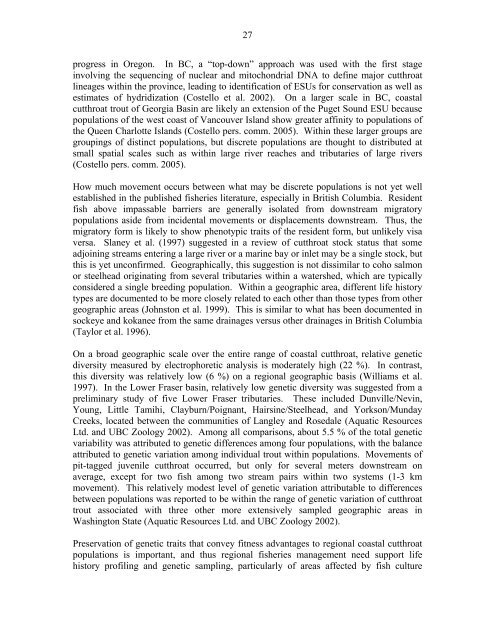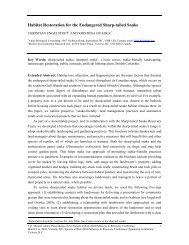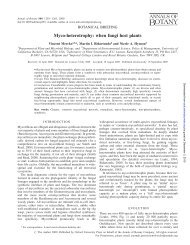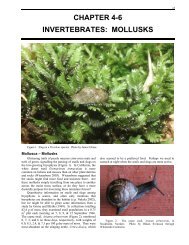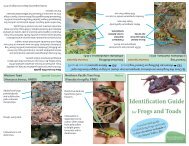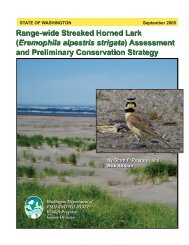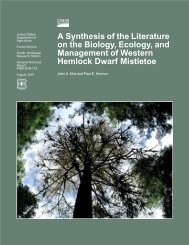Coastal Cutthroat Trout as Sentinels of Lower Mainland Watershed ...
Coastal Cutthroat Trout as Sentinels of Lower Mainland Watershed ...
Coastal Cutthroat Trout as Sentinels of Lower Mainland Watershed ...
Create successful ePaper yourself
Turn your PDF publications into a flip-book with our unique Google optimized e-Paper software.
27progress in Oregon. In BC, a “top-down” approach w<strong>as</strong> used with the first stageinvolving the sequencing <strong>of</strong> nuclear and mitochondrial DNA to define major cutthroatlineages within the province, leading to identification <strong>of</strong> ESUs for conservation <strong>as</strong> well <strong>as</strong>estimates <strong>of</strong> hydridization (Costello et al. 2002). On a larger scale in BC, co<strong>as</strong>talcutthroat trout <strong>of</strong> Georgia B<strong>as</strong>in are likely an extension <strong>of</strong> the Puget Sound ESU becausepopulations <strong>of</strong> the west co<strong>as</strong>t <strong>of</strong> Vancouver Island show greater affinity to populations <strong>of</strong>the Queen Charlotte Islands (Costello pers. comm. 2005). Within these larger groups aregroupings <strong>of</strong> distinct populations, but discrete populations are thought to distributed atsmall spatial scales such <strong>as</strong> within large river reaches and tributaries <strong>of</strong> large rivers(Costello pers. comm. 2005).How much movement occurs between what may be discrete populations is not yet wellestablished in the published fisheries literature, especially in British Columbia. Residentfish above imp<strong>as</strong>sable barriers are generally isolated from downstream migratorypopulations <strong>as</strong>ide from incidental movements or displacements downstream. Thus, themigratory form is likely to show phenotypic traits <strong>of</strong> the resident form, but unlikely visaversa. Slaney et al. (1997) suggested in a review <strong>of</strong> cutthroat stock status that someadjoining streams entering a large river or a marine bay or inlet may be a single stock, butthis is yet unconfirmed. Geographically, this suggestion is not dissimilar to coho salmonor steelhead originating from several tributaries within a watershed, which are typicallyconsidered a single breeding population. Within a geographic area, different life historytypes are documented to be more closely related to each other than those types from othergeographic are<strong>as</strong> (Johnston et al. 1999). This is similar to what h<strong>as</strong> been documented insockeye and kokanee from the same drainages versus other drainages in British Columbia(Taylor et al. 1996).On a broad geographic scale over the entire range <strong>of</strong> co<strong>as</strong>tal cutthroat, relative geneticdiversity me<strong>as</strong>ured by electrophoretic analysis is moderately high (22 %). In contr<strong>as</strong>t,this diversity w<strong>as</strong> relatively low (6 %) on a regional geographic b<strong>as</strong>is (Williams et al.1997). In the <strong>Lower</strong> Fr<strong>as</strong>er b<strong>as</strong>in, relatively low genetic diversity w<strong>as</strong> suggested from apreliminary study <strong>of</strong> five <strong>Lower</strong> Fr<strong>as</strong>er tributaries. These included Dunville/Nevin,Young, Little Tamihi, Clayburn/Poignant, Hairsine/Steelhead, and Yorkson/MundayCreeks, located between the communities <strong>of</strong> Langley and Rosedale (Aquatic ResourcesLtd. and UBC Zoology 2002). Among all comparisons, about 5.5 % <strong>of</strong> the total geneticvariability w<strong>as</strong> attributed to genetic differences among four populations, with the balanceattributed to genetic variation among individual trout within populations. Movements <strong>of</strong>pit-tagged juvenile cutthroat occurred, but only for several meters downstream onaverage, except for two fish among two stream pairs within two systems (1-3 kmmovement). This relatively modest level <strong>of</strong> genetic variation attributable to differencesbetween populations w<strong>as</strong> reported to be within the range <strong>of</strong> genetic variation <strong>of</strong> cutthroattrout <strong>as</strong>sociated with three other more extensively sampled geographic are<strong>as</strong> inW<strong>as</strong>hington State (Aquatic Resources Ltd. and UBC Zoology 2002).Preservation <strong>of</strong> genetic traits that convey fitness advantages to regional co<strong>as</strong>tal cutthroatpopulations is important, and thus regional fisheries management need support lifehistory pr<strong>of</strong>iling and genetic sampling, particularly <strong>of</strong> are<strong>as</strong> affected by fish culture


